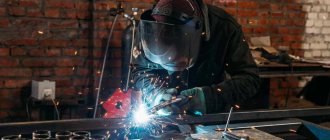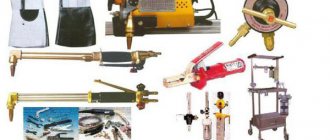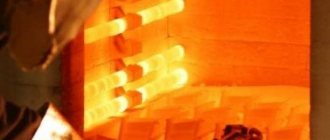The areas of the welded parts located in the zone and around the seam are subject to uneven temperature changes - they instantly heat up to a state of melting and cool down rapidly. As a result of such processes, the metal first begins to expand. It affects nearby areas that have a completely different temperature. The effect of expanding steel will be greater, the lower the thermal conductivity of the metal. As a result, powerful stresses arise, leading to deformation of the material. They negatively affect the result of the work, so it is necessary to understand how to relieve metal stress after welding.
Residual stress
Stresses arise in the metal during welding and after the process is completed. In the latter case, they form as the part cools and are called residual. Such stresses are present in almost all structural materials throughout the entire operational period. They pose the greatest danger to products, as they cause changes in the dimensions and shape of parts. This is why it is so important to relieve stress in the metal after welding. This will eliminate the possibility of changes in the appearance of the product and reduce the degree of reduction in its performance characteristics. If the residual stresses in the material are too large, then there is a possibility that the part will not be usable.
The shape change of products made by welding occurs due to the movement of the connected elements, since deformations appear at each point of the metal. There are several types of shape changes:
- longitudinal shortenings resulting from shrinkage in the same direction;
- plane bending;
- transverse shortenings; also arising as a result of shrinkage in the corresponding direction;
- angular deformations when T-joints and stock joints are made;
- changes in the shape of beam structures occurring due to deformation of transverse and longitudinal welding seams (in rare cases, twisting of beams occurs).
To avoid changing the shape of a product of any type, you need to specifically know how to relieve stress in the metal after welding. There are several ways. The techniques are used simultaneously or separately.
Types of heat treatment
The method of heat treatment of the weld is chosen depending on the goal:
- After thermal rest, the residual stress and the amount of hydrogen inside the seam are reduced. The process is carried out at temperatures up to 300⁰C with exposure for 1.5 - 2 hours. This method is used to process welded joints on thick-walled structures when it is not possible to use other types.
- Tempering, due to the destruction of hardening structures, reduces stress by 90%, increases ductility and resistance to impact loads. Heating up to 600 - 700⁰C, holding time up to 3 hours. The method is used on pearlitic steels.
- Normalization is performed at 800⁰C with a holding time of 20 - 40 minutes on thin-walled parts. After the process is completed, the structure becomes fine-grained and homogeneous.
- Austenization is carried out on high-alloy types of steel to relieve stress and restore ductility. Heating to 1100⁰C, holding for two hours, followed by natural cooling.
- For annealing after welding, heat treatment will be performed at 970⁰C with exposure for 3 hours and cooling under natural conditions. Used when working with high-alloy steels to improve corrosion resistance.
The temperature is controlled by changes in the color of marks applied to the surface of parts with a thermal pencil or thermal paint. However, the measurement accuracy of this method is low, so pyrometers and thermal imagers are more often used. They can be manual or built into systems for automatically maintaining temperature at a given level.
If high demands are placed on the quality of welded joints, heat treatment is mandatory. After it is carried out, cracks, breaks, and corrosion will not appear on the seams. When using modern equipment, heat treatment will not take much time.
Heat treatment
One of the options for stress relief is high-temperature tempering. The technical measure is used during the jointing of carbon alloys. It is carried out by heating to 630-650 °C. After holding the temperature for 2-3 minutes per 1 mm of steel thickness, the part is cooled.
The temperature of the product is reduced slowly. This avoids re-formation of tension. The speed parameter depends on the composition of the metal. It decreases with an increase in the elements in the alloy that affect its hardening.
Process duration
The duration of heat treatment of welded joints depends on the type and thickness of the metal. Chrome-molybdenum steel grades and its alloys containing vanadium are heated by radiation or induction. The duration of the process is determined from the table:
| Thickness, cm | Radiation, minutes | Induction, minutes |
| Up to 2.0 | 40 | 25 |
| 2.1 — 2.5 | 70 | 40 |
| 2.6 — 3.0 | 100 | 40 |
| 3.1 — 3.5 | 120 | 60 |
| 3.6 — 4.5 | 140 | 70 |
| 4.6 — 6.0 | 160 | 90 |
| 6.1 — 8.0 | 160 | 110 |
| 8.1 — 10 | 1600 | 140 |
Before heating, the weld seam is cleaned of slag. The induction method performs the procedure faster, but consumes more electricity.
Heating process during thermal treatment
Important!
The duration of heat treatment of welded joints depends on the type and thickness of the metal.
Argon arc technique
The meaning of argon arc processing is to melt the area located between the weld and the base metal. The process is performed with a non-consumable electrode rod in an argon environment. This effect allows you to get rid of stress in the transition zone. However, crystallization subsequently occurs, as a result of which they appear again. The magnitude of the newly appeared stresses is significantly less than the initial values. The difference reaches 70%.
Advice! Using this technique, you can not only reduce stress, but also obtain a smooth transition in the area located between the seam and the metal of the structure. Thanks to this, the strength characteristics of the metal structure increase.
Forging the weld seam
The technological operation is carried out with the aim of creating additional deformations. They allow you to completely get rid of residual stresses. Forging is carried out when the joint cools down. The event is carried out if the temperature exceeds 450 °C. The connection can also be forged at temperatures below 150 °C. In other cases, the process is not performed because there is a risk of tears.
The operation is carried out manually using a hammer. Its weight is on average 1000 g. It is allowed to use a pneumatic hammer. When forging multi-layer joints is carried out, the activity is not carried out for the 1st and last layer, since there is a high probability of crack formation. The method allows you to get rid of the stressed state during the elimination of defects and when creating a closing joint.
Thermal straightening
This method involves heating the joint using a gas flame. An electric arc generated from a non-consumable electrode rod can also be used. The material is heated to 750-850 °C. Then rapid expansion of the alloy occurs. However, adjacent layers prevent the metal from expanding. Because of this, plastic deformation of the heated zone occurs. When cooling occurs, the preheated area begins to shrink. As a result, the deformation is completely or partially eliminated.
Knowing how to relieve metal stress after welding will reduce the likelihood of a decrease in the strength of welded structures. This is especially important in conditions that favor brittle weld failure. Using the methods described above, it is possible to avoid defects during the operation of welded metal structures.
Heat treatment of steels is one of the most important operations in mechanical engineering, the correct implementation of which determines the quality of the products. Quenching and tempering of steels are one of the various types of heat treatment of metals.
Thermal effects on metal change its properties and structure. This makes it possible to increase the mechanical properties of the material, the durability and reliability of products, as well as reduce the size and weight of mechanisms and machines. In addition, thanks to heat treatment, cheaper alloys can be used for the manufacture of various parts.
It also won’t hurt you to know how to cook with a semi-automatic machine.
As the Steel Was Tempered
Read also: How to refill a blowtorch
Heat treatment of steel involves applying heat to the metal under certain conditions to change its structure and properties.
Heat treatment operations include:
- annealing;
- normalization;
- aging;
- steel hardening and steel tempering (etc.).
Heat treatment of steel: hardening, tempering - depends on the following factors:
- heating temperatures;
- heating time (speed);
- duration of exposure at a given temperature;
- cooling rate.
Equipment used
The following types of equipment are used for heat treatment of welds:
- Induction. The operating principle is based on heating the metal by eddy currents created by an induction coil (inductor) connected to a high-frequency generator. The heated area is preliminarily covered with asbestos. On top of it, coil turns are wound with a flexible wire in increments of 2.5 cm at a distance of 25 cm on both sides of the joint. Pads with wires located inside are also used as an inductor. The technology ensures fast, uniform heating of the joint area, regardless of the position of the parts.
- Radiation. Heating is carried out by heat from nichrome wires through which electric current passes. Flexible heating elements are convenient for processing complex shaped joints. Radiation equipment is more effective than induction equipment when working with metals with low electromagnetic characteristics.
- Gas is advantageous for use because it does not require electricity. However, it takes a long time to heat up. Therefore, the equipment is used on small structures. To ensure uniform heating of the joint, the work is performed with two multi-flame acetylene torches simultaneously on both sides.
- Muffle furnaces are used to work with small parts. They are also used on small diameter pipelines.
Hardening
Steel hardening is a heat treatment process, the essence of which is to heat the steel to a temperature above the critical temperature, followed by rapid cooling. As a result of this operation, the hardness and strength of steel increase, and ductility decreases.
When steels are heated and cooled, the atomic lattice is rearranged. The critical temperature values for different grades of steel are not the same: they depend on the content of carbon and alloying impurities, as well as on the rate of heating and cooling.
After hardening, the steel becomes brittle and hard. When heated in thermal furnaces, the surface layer of products becomes covered with scale and is decarbonized the more, the higher the heating temperature and the holding time in the furnace. If the parts have a small allowance for further processing, then this defect is irreparable. Hardening modes for hardening steel depend on its composition and technical requirements for the product.
During hardening, parts should be cooled quickly so that austenite does not have time to transform into intermediate structures (sorbitol or troostite). The required cooling rate is ensured by selecting the cooling medium. In this case, excessively rapid cooling leads to cracks or warping of the product. To avoid this, in the temperature range from 300 to 200 degrees, the cooling rate must be slowed down, using combined hardening methods. The method of immersing the part in a cooling medium is of great importance to reduce warping of the product.
Features of the event
Heat treatment is performed in stages:
- heat only the seam or together with areas near it;
- maintain the temperature for a certain time;
- systematically cooled to ambient temperature.
The temperature of heat treatment depends on the tasks being performed.
Depending on the tasks being solved, heat treatment after welding is performed at temperatures from 600 to 1100⁰C. Several processing methods have been developed with different heating schedules, holding times, and cooling. The method and equipment are selected depending on the grade of metal, thickness and configuration of parts.
Heat treatment should be applied to welded seams of long-distance pipelines, connections on lifting mechanisms, vessels and containers operating under pressure. The procedure cannot be delayed for more than three days. To increase corrosion resistance, heat treatment is carried out immediately after welding is completed.
Heating the metal
All steel hardening methods consist of:
- heating steel;
- subsequent holding to achieve through-heating of the product and completion of structural transformations;
- cooling at a certain speed.
Carbon steel products are heated in chamber furnaces. In this case, preheating is not required, since these steel grades are not subject to cracking or warping.
Complex products (for example, a tool with protruding thin edges or sharp transitions) are preheated:
- in salt baths by immersing two or three times for 2 - 4 seconds;
- in separate ovens up to a temperature of 400 - 500 degrees Celsius.
Heating of all parts of the product should proceed evenly. If this cannot be achieved in one step (large forgings), then two holding times are made for through heating.
If only one part is placed in the oven, the heating time is reduced. For example, one 24 mm thick disk cutter heats up within 13 minutes, and ten such products heat up within 18 minutes.
What and when is heat treated
All pipelines with a diameter of 108 mm or more and having a wall of 10 mm or more must be neutralized to neutralize residual effects from electric arc welding. For this purpose, induction heating of the product with a current with a frequency of 50 Hz is used. Heat treatment can affect the metal of a pipe with a wall of 45-60 mm, for which flexible electric heating wires or muffle furnaces are used. If the wall thickness of the structure is no more than 25 mm, then the gas-flame heating method can be used. In all cases, the factor of uniformity of temperature distribution in all directions from the welding joint is important.
Joints made using pipes made of steel 12XIMIF and its variety 15XIMIF, having a main wall thickness of 45 mm, must be subjected to heat treatment immediately after completion of welding work. Cooling of the material should not be allowed to reach a temperature of 300 degrees. Joints made of similar steels on pipes with a diameter of 600 mm, with a wall of 25 mm, are processed in the same time period. If it is impossible to complete the process, the connection must be covered with a 15 mm layer of thermal insulation, and treatment must be carried out at the first opportunity. The maximum period for carrying out this work is three days.
It is necessary to heat treat not only the circumferential seams on the pipeline, but also welded bends, taps, and plugs. The fastening for the pipe section, which was connected by welding, must also be treated with heat.
Product protection from scale and decarburization
For products whose surfaces are not ground after heat treatment, carbon burnout and scale formation are unacceptable. Surfaces are protected from such defects by using protective gases supplied into the cavity of the electric furnace. Of course, this technique is only possible in special sealed ovens. The source of gas supplied to the heating zone is shielding gas generators. They can operate on methane, ammonia and other hydrocarbon gases.
If there is no protective atmosphere, then before heating the products are packaged in containers and covered with used carburizer and cast iron shavings (the heat engineer should know that charcoal does not protect tool steels from decarburization). To prevent air from getting into the container, it is coated with clay.
When heated, salt baths prevent the metal from oxidizing, but do not protect against decarbonization. Therefore, in production they are deoxidized at least twice per shift with brown salt, blood salt or boric acid. Salt baths operating at temperatures of 760 – 1000 degrees Celsius are very effectively deoxidized by charcoal. To do this, a glass with many holes over the entire surface is filled with dried charcoal, closed with a lid (so that the coal does not float up) and, after heating, lowered to the bottom of the salt bath. First, a significant number of flames appear, then it decreases. If you deoxidize the bath three times during a shift in this way, the heated products will be completely protected from decarbonization.
The degree of deoxidation of salt baths is checked very simply: an ordinary blade, heated in a bath for 5 - 7 minutes in a high-quality deoxidized bath and hardened in water, will break, not bend.
Types of equipment
Heat treatment is carried out by several types of means, the choice of which depends on the thickness of the pipes being welded and the local availability of equipment. There are three main methods of heating the heat-affected zone.
Induction
A device is installed at the workplace that generates alternating high-frequency voltage. A heating element, which is a flexible wire, is connected to it. The latter is wound onto a welding joint, previously wrapped in asbestos for thermal insulation. This technology can be used regardless of the position of the pipe in space (vertical or horizontal).
The wire is wound close to the insulator, and a gap of 25 mm is left between the turns. In this way, a 250 mm section of pipe on each side of the seam should be covered. After the correct application of the turns, the device is turned on for a time intended for the specific thickness of the pipeline wall. The voltage passing through the turns of the wire creates induction and heats the product. In a similar way, one-piece belts are laid, containing a number of wires inside them, which immediately cover the required width of the pipe.
https://www.youtube.com/watch?v=IjuKarv04Ec
Radiation
The second common method of heat treatment of welded joints is the radiation method. Here, the thermal effect comes from special nichrome wires through which voltage flows, and the heat-affected zone is heated directly by the heat from the wire, and not by current induction, as in the first method. The heating element is laid on a base made of thermal insulation.
Gas-flame
The cheapest way to perform heat treatment of a weld is a flame from the combustion of a mixture of acetylene and oxygen. This is suitable for pipes with a diameter of no more than 100mm. A mouthpiece with a large hole is installed on the burner. To ensure uniform heat supply from the flame, an asbestos funnel is placed on the nozzle, distributing the flame over a width of 250 mm. Proper heating is produced simultaneously by two burners operating on each side.
Coolants
The main coolant for steel is water. If you add a small amount of salts or soap to the water, the cooling rate will change. Therefore, under no circumstances should the quenching tank be used for other purposes (for example, washing hands). To achieve the same hardness on the hardened surface, it is necessary to maintain the coolant temperature at 20 - 30 degrees. You should not change the water in the tank frequently. It is absolutely unacceptable to cool the product in running water.
The disadvantage of water hardening is the formation of cracks and warping. Therefore, only products of simple shapes or cemented ones are hardened using this method.
- When hardening products of complex configurations made of structural steel, a fifty percent solution of caustic soda is used (cold or heated to 50 - 60 degrees). Parts heated in a salt bath and hardened in this solution turn out light. The solution temperature should not be allowed to exceed 60 degrees.
Modes
Vapors formed during quenching in a caustic solution are harmful to humans, so the quenching bath must be equipped with exhaust ventilation.
- Alloy steel is hardened in mineral oils. By the way, thin carbon steel products are also carried out in oil. The main advantage of oil baths is that the cooling rate does not depend on the oil temperature: at a temperature of 20 degrees and 150 degrees, the product will cool at the same rate.
Read also: Thicknesser for wood reviews
Be careful not to let water get into the oil bath, as this may cause the product to crack. What is interesting: in oil heated to a temperature above 100 degrees, the ingress of water does not lead to the appearance of cracks in the metal.
The disadvantage of an oil bath is:
- release of harmful gases during hardening;
- formation of plaque on the product;
- oil's tendency to flammability;
- gradual deterioration of hardening ability.
- Steels with stable austenite (for example, X12M) can be cooled with air supplied by a compressor or fan. At the same time, it is important to prevent water from entering the air duct: this can lead to the formation of cracks in the product.
- Step hardening is performed in hot oil, molten alkalis, and low-melting salts.
- Intermittent hardening of steels in two cooling environments is used for processing complex parts made of carbon steels. First they are cooled in water to a temperature of 250 - 200 degrees, and then in oil. The product is kept in water for no more than 1 - 2 seconds for every 5 - 6 mm of thickness. If the exposure time in water is increased, cracks will inevitably appear on the product. Transferring the part from water to oil must be done very quickly.
Do you need to cut metal quickly and efficiently? Use a plasma cutter! How to do it correctly, read this article.
If you are interested in how to turn metal products, read the article at https://elsvarkin.ru/obrabotka-metalla/tokarnaya-obrabotka-metalla-obshhie-svedeniya/ link.
Process modes
Different types of steel are subjected to heat treatment in a specific time period. The mode and wall thickness of the product are affected. On chromium-molybdenum steels and their alloys with vanadium, heating is used by induction, with a current frequency of 50 Hz or higher, or by radiation according to the following indicators:
| Wall thickness, mm | Radiation method, minutes | Induction method, minutes |
| Up to 20 | 40 | 25 |
| 21-25 | 70 | 40 |
| 26-30 | 100 | 40 |
| 31-35 | 120 | 60 |
| 36-45 | 140 | 70 |
| 46-60 | 160 | 90 |
| 61-80 | 160 | 110 |
| 81-100 | 160 | 140 |








